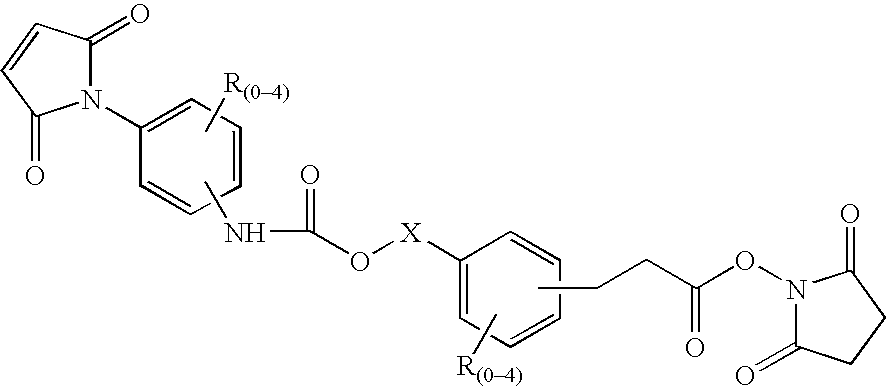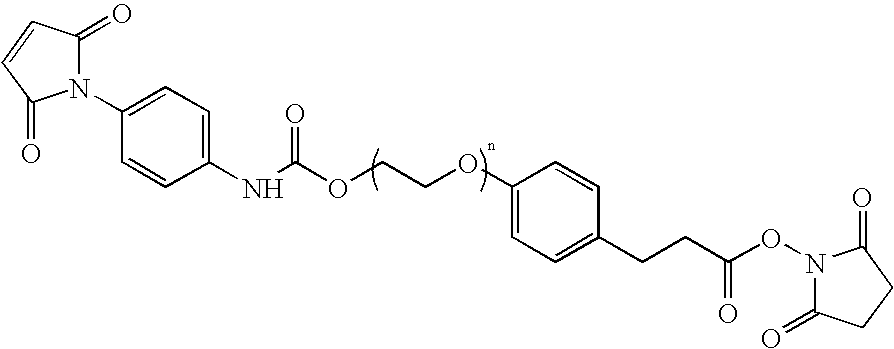N-aryl-carbamic acid ester-derived and valeric acid ester-derived cross-linkers and conjugates, and methods for their synthesis and use
a technology of valeric acid ester and narylcarbamic acid, which is applied in the field of new carbamic acid and valeric acid esters, can solve problems such as loss of activity, and achieve the effects of sufficient water solubility, reduced synthesis cost, and improved synthesis efficiency
- Summary
- Abstract
- Description
- Claims
- Application Information
AI Technical Summary
Benefits of technology
Problems solved by technology
Method used
Image
Examples
example 1
Preparation of NHS-N-Aryl Carbamic Acid Ester-Polyethylene Oxide-Valeric Acid-Maleimide (NCVM) Bifunctional Linker
[0126]A solution of 20 mmol poly(ethylene glycol) having an average molecular weight of 3400 in 300 mL toluene was refluxed with stirring, and the azeotroped water collected using a Dean-Stark trap and discarded. After about 90 mL of distillate was collected and discarded in this manner, the remaining contents were cooled to about 30° C. and treated with 40 mmol sodium hydride. After 1 hour, 40 mmol ethyl-5-bromovalerate was added with rapid stirring. The solution was stirred overnight, at which time a solid precipitate had formed. The solid was heated to a liquid and evaporated to dryness.
[0127]The remaining solid residue was dissolved in 150 mL methylene chloride, re-evaporated to dryness, and 100 mL 1N NaOH added to the remaining solid residue. The mixture was swirled to dissolve, and left at room temperature overnight. The resulting solution was acidified to pH4 was ...
example 2
Preparation of NHS-N-Aryl Carbamic Acid Ester-Polyethylene Oxide-Maleimide (NCAM) Bifunctional Linker
[0132]A solution of 40 mmol poly(ethylene glycol) having an average molecular weight of 3400 in 300 mL toluene was refluxed with stirring, and the azeotroped water collected using a Dean and Stark trap and discarded. After about 250 mL of distillate was collected and discarded in this manner, the remaining contents were evaporated and solid triphenyl phosphine (23.88 mmol) and methyl-4-hydroxyphenylpropionate (23.88 mmol) added to the residue. The solids were dissolved in 205 mL tetrahydrofuran, and 23.88 mmol diisopropylazodicarboxylate was added with stirring. The solution was stirred overnight under argon. The volume of the solution was reduced by about 50% by evaporation, and 200 mL diethyl ether was added. The resulting solution was poured into 1.3 L diethyl ether, and brought to a final volume of 1.8 L. The resulting solid was collected, washed with 3×100 mL diethyl ether and d...
example 3
Preparation of NHS-Polyethylene Oxide-Valeric Acid Ester-Maleimide (NVAM) Bifunctional Linker
[0137]A solution of 20 mmol poly(ethylene glycol) having an average molecular weight of 3400 in 300 mL toluene was refluxed with stirring, and the azeotroped water collected using a Dean-Stark trap and discarded. After about 90 mL of distillate was collected and discarded in this manner, the remaining contents were cooled to about 30° C. and treated with 40 mmol sodium hydride. After 1 hour, 40 mmol ethyl-5-bromovalerate was added with rapid stirring. The solution was stirred overnight, at which time a solid precipitate had formed. The solid was heated to a liquid and evaporated to dryness.
[0138]The remaining solid residue was dissolved in 150 mL methylene chloride, re-evaporated to dryness, and 100 mL 1N NaOH added to the remaining solid residue. The mixture was swirled to dissolve, and left at room temperature overnight. The resulting solution was acidified to pH4 was added to the combined...
PUM
| Property | Measurement | Unit |
|---|---|---|
| Solubility (mass) | aaaaa | aaaaa |
Abstract
Description
Claims
Application Information
 Login to View More
Login to View More - R&D
- Intellectual Property
- Life Sciences
- Materials
- Tech Scout
- Unparalleled Data Quality
- Higher Quality Content
- 60% Fewer Hallucinations
Browse by: Latest US Patents, China's latest patents, Technical Efficacy Thesaurus, Application Domain, Technology Topic, Popular Technical Reports.
© 2025 PatSnap. All rights reserved.Legal|Privacy policy|Modern Slavery Act Transparency Statement|Sitemap|About US| Contact US: help@patsnap.com



